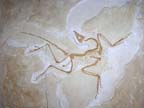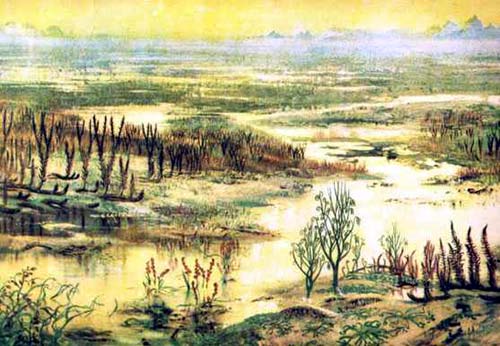 |
 |
 |
 |
 |
Produced
by the Population Genetics and Evolution class, Furman University |
||||
 |
 |
 |
 |
 |
Produced
by the Population Genetics and Evolution class, Furman University |
||||
 |
The
Devonian: Rhyniophytes |
 |
||
| Rhyniophytes
are a group of primitive vascular plants, consisted of naked, dichotomously
branching axes that were terminally composed of fusiform sporangia (Palaeobotanical
Research Group 2003). They were discovered in the Rhynie Chert in Aberdeenshire,
Scotland; a deposit containing the oldest and most completely preserved
terrestrial ecosystem on Earth. Their S-type walls were composed of annular
or helical thickenings made of spongy material that were thin and decay-resistant
(Friedman and Cook 2000). A lack of “true” roots was augmented
by single-celled rhizoids that were used for nutrient and water uptake
(Palaeobotanical Research Group 2003). The lack of large roots and their
proposed reliance of photosynthesis in its stems have lead scientists
to wonder how these early plants withstood high velocity winds. Two possible
solutions were that the stems grew quickly and they experienced a shorter
life span, or that when the stems were lost, they were rapidly replaced
by new shoots from the rhizomes (Taylor 2009). Rhyniophytes are one group
of early vascular plants radiating in the Devonian and changing the terrestrial
landscape. Page by Iggy Gaska |
 |
| An illustrated view of the environment of the Devonian Rhynie Chert. by Zdenek Burian (from:Palaeos.com) | |
|
Friedman WE, Cook MR. 2000. The origins and early evolution of traechids in vascular plants: Integration of palaeobotanical and neobotanical data. Philosophical Transactions of the Royal Academy of London. 355: 857-868. Paleobotanical Research Group. 2003. History of Paleozoic Forests The Earliest Land Plants. University of Munster. Germany. Taylor C. 2009. Before the Word for World was Forest. Catalogue of organisms. |